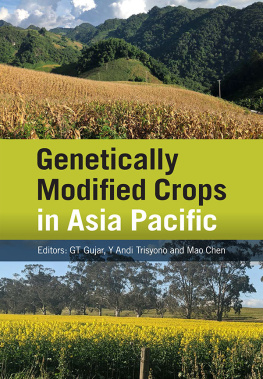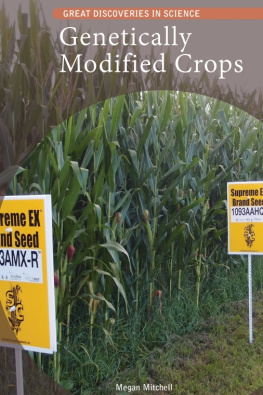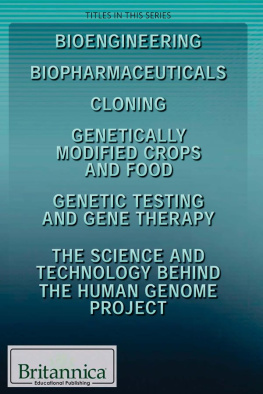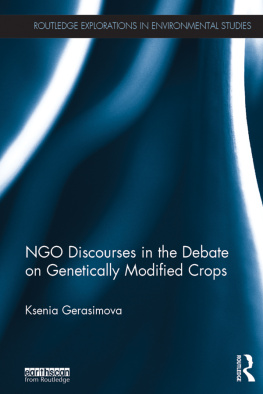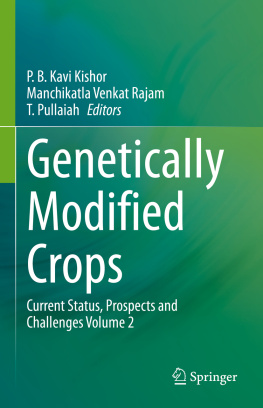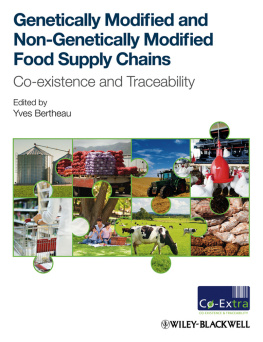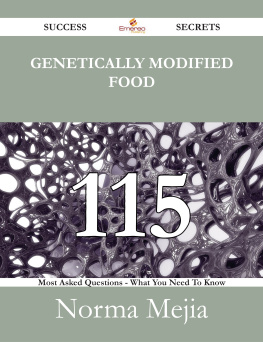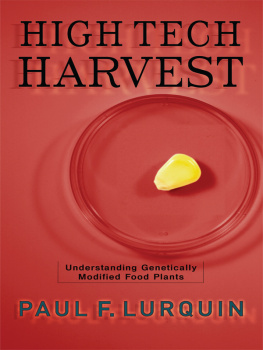Gujar GT (editor) - Genetically modified crops in Asia Pacific
Here you can read online Gujar GT (editor) - Genetically modified crops in Asia Pacific full text of the book (entire story) in english for free. Download pdf and epub, get meaning, cover and reviews about this ebook. year: 2021, genre: Politics. Description of the work, (preface) as well as reviews are available. Best literature library LitArk.com created for fans of good reading and offers a wide selection of genres:
Romance novel
Science fiction
Adventure
Detective
Science
History
Home and family
Prose
Art
Politics
Computer
Non-fiction
Religion
Business
Children
Humor
Choose a favorite category and find really read worthwhile books. Enjoy immersion in the world of imagination, feel the emotions of the characters or learn something new for yourself, make an fascinating discovery.
- Book:Genetically modified crops in Asia Pacific
- Author:
- Genre:
- Year:2021
- Rating:3 / 5
- Favourites:Add to favourites
- Your mark:
- 60
- 1
- 2
- 3
- 4
- 5
Genetically modified crops in Asia Pacific: summary, description and annotation
We offer to read an annotation, description, summary or preface (depends on what the author of the book "Genetically modified crops in Asia Pacific" wrote himself). If you haven't found the necessary information about the book — write in the comments, we will try to find it.
Genetically modified crops in Asia Pacific — read online for free the complete book (whole text) full work
Below is the text of the book, divided by pages. System saving the place of the last page read, allows you to conveniently read the book "Genetically modified crops in Asia Pacific" online for free, without having to search again every time where you left off. Put a bookmark, and you can go to the page where you finished reading at any time.
Font size:
Interval:
Bookmark:

Modified Crops
in Asia Pacific
Dedicated to our parents and wives for their love

Copyright The Authors 2021. All rights reserved.
Except under the conditions described in the Australian Copyright Act 1968 and subsequent amendments, no part of this publication may be reproduced, stored in a retrieval system or transmitted in any form or by any means, electronic, mechanical, photocopying, recording, duplicating or otherwise, without the prior permission of the copyright owner. Contact CSIRO Publishing for all permission requests.
The authors and editors assert their moral rights, including the right to be identified as an author or editor.
A catalogue record for this book is available from the National Library of Australia.
ISBN: 9781486310906 (hbk)
ISBN: 9781486310913 (epdf)
ISBN: 9781486310920 (epub)
Published in print in Australia and New Zealand, and in all other formats throughout the world, by CSIRO Publishing.
CSIRO Publishing
Locked Bag 10
Clayton South VIC 3169
Australia
Telephone:+61 3 9545 8400
Email:
Website: www.publish.csiro.au
A catalogue record for this book is available from the British Library, London, UK.
Published in print only, throughout the world (except in Australia and New Zealand), by CABI.
ISBN 9781789248418
| CABI | CABI |
| Nosworthy Way | We Work |
| Wallingford | One Lincoln Street, 24th Floor |
| Oxfordshire OX10 8DE | Boston, MA 02111 |
| UK | USA |
| Tel: +44 (0)1491 832111 | Tel: +1 (617)682-9015 |
| Fax: +44 (0)1491 833508 | E-mail: |
| Email: | |
| Website: www.cabi.org |
Front cover: (top) Corn field in Son La, Vietnam (photo by Mao Chen); (bottom) Canola field in Australia (photo by Pragna Prathap and Aleena Joy).
Edited by Adrienne de Kretser, Righting Writing
Cover design by James Kelly
Typeset by Envisage
Printed in Singapore by Markono Print Media Pte Ltd
CSIRO Publishing publishes and distributes scientific, technical and health science books, magazines and journals from Australia to a worldwide audience and conducts these activities autonomously from the research activities of the Commonwealth Scientific and Industrial Research Organisation (CSIRO). The views expressed in this publication are those of the author(s) and do not necessarily represent those of, and should not be attributed to, the publisher or CSIRO. The copyright owner shall not be liable for technical or other errors or omissions contained herein. The reader/user accepts all risks and responsibility for losses, damages, costs and other consequences resulting directly or indirectly from using this information.
This book is printed on paper certified to the standard requirements of Forest Stewardship Council. The FSC promotes environmentally appropriate, socially beneficial and economically viable management of the worlds forests.
Sep20_01
Most of the Asia Pacific region comprises developing countries. Rural population accounts for ~50%, and more than 20% of the population live in poverty. Nearly half of the worlds food-insecure people and two-thirds of its undernourished people live in this region. Agriculture is overwhelmed with severe limitations like poor agri-infrastructure, technological development and management of natural resources. The Asia Pacific region has emerged as a major importer of food grains, despite being agriculture-intensive. Therefore, it is of great significance to improve agricultural production capacity through scientific and technological innovations to solve the food scarcity in Asia.
Transgenic technology offers great promise for breeding crops selectively with genes of interest isolated from different sources. This is not possible with conventional crop improvement tactics. In 2018, biotech/genetically modified (GM) crops were grown across 191.7 million ha the largest area since their introduction in 1996. These crops have helped to enhance productivity and farm income and to improve environmental quality.
The Asia Pacific region in general lags in the use of biotech/GM technologies, despite the success of GM crops in some of its member nations. India, China, Australia and the Philippines are the major countries growing these crops, while many have approved them for food and feed use. Cultivation of GM crops can help alleviate hunger and malnutrition in the Asia Pacific region, as the UNs sustainable development goal of achieving zero hunger by 2030 remains a challenge.
This book Genetically Modified Crops in Asia Pacific comprehensively reviews the development and commercialisation of GM crops in Asia Pacific countries along with other issues like sustainability, environmental safety, biotechnology policies and regulations. I believe that its publication will help all stakeholders in Asia Pacific countries in the promotion of agricultural production and economy. I congratulate the editors as well as authors for their contributions in this excellent book.
Kongming Wu
Vice President and Professor
Chinese Academy of Agricultural Sciences
Beijing
20 January 2020
This book Genetically Modified Crops in Asia Pacific is our attempt to contribute to the food security of the region where most of the worlds poor live, among 60% of the global population on 30% of the global land mass. It also represents an immense diversity in terms of food habits, living standards, education, religion, geography and politics. GM crops and other agricultural technologies have emerged as forerunners to protect crops against biotic as well as abiotic stresses. Other traits related to specific nutrients and aesthetic values are also added to these crops through GM technologies. Time and again, elaborate assessments have shown the safety of GM crops (NASEM Report 2016 at http://nas-sites.org/ge-crops/). In 2018, as per ISAAA, biotech crops were planted on 191.7 million hectares in 26 countries, a record increase in area of more than 100-fold, from 1.7 million hectares in 1996. Biotech crops increased crop production by 658 million tons valued at US$186 billion in 19962016, and reduced environmental impact by (i) saving 671 million kg of active ingredients of pesticides in 19962016, (ii) reducing Environmental Impact Quotient by 18.4% in 19962016 and (iii) reducing CO2 emissions in 2016 by 27 billion kg. Biotech crops also helped alleviate poverty through uplifting the economic conditions of 1617 million small farmers and their families, totalling >65 million people (http://www.isaaa.org/resources/publications/briefs/54/).
The developed member nations of the Asia Pacific region have readily accepted GM crops for food, feed and environmental release, with Australia in the lead. The developing member states have cautiously followed this path of crop improvement. No member state has given up on the immense potential of biotechnology for the benefit of its people. Almost every country has faced opposition to GM technology due to its allegedly ill effects on human health and environment, and the possibility of misuse of genetic diversity by technology developers, mostly in the developed nations. Over the years, the international community has played a positive role in mitigating this opposition, with 196 nations becoming party to the Convention on Biological Diversity, 171 nations to the Cartegena Protocol on biosafety and 122 to the Nagoya Protocol on access and benefit sharing. Many member nations of Asia Pacific have accordingly enacted necessary legislation for approval of GM crops, which involved collaboration with the international community to solve locally perceived constraints to achieving higher crop productivity. Development of insect-protective Bt brinjal (eggplant), drought-tolerant sugarcane, insect-resistant rice, late blight resistant GM potato and golden rice are pointers in this direction.
Font size:
Interval:
Bookmark:
Similar books «Genetically modified crops in Asia Pacific»
Look at similar books to Genetically modified crops in Asia Pacific. We have selected literature similar in name and meaning in the hope of providing readers with more options to find new, interesting, not yet read works.
Discussion, reviews of the book Genetically modified crops in Asia Pacific and just readers' own opinions. Leave your comments, write what you think about the work, its meaning or the main characters. Specify what exactly you liked and what you didn't like, and why you think so.

